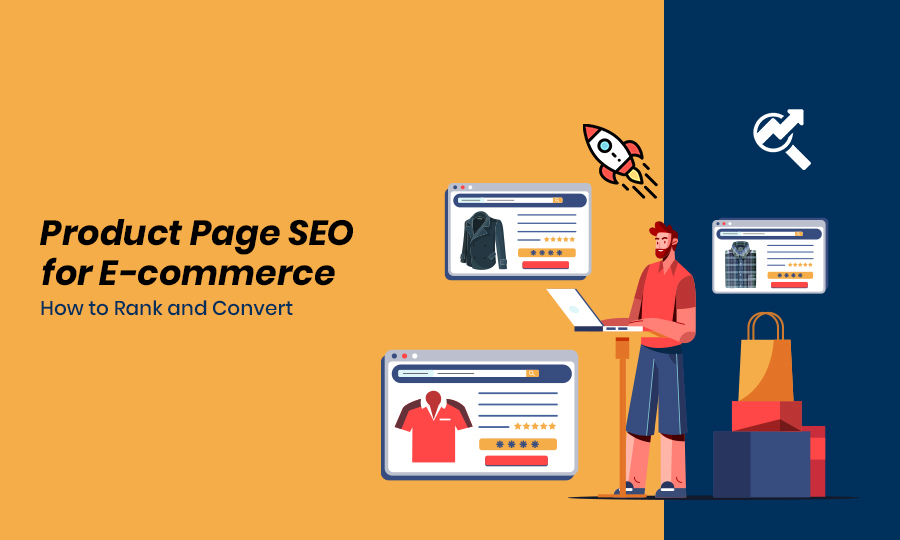Nearly 50% of e-commerce sessions include product page views, which is much higher than the other micro-conversions. This highlights the significant importance of optimizing product pages since they represent the highest engagement in the customer journey.
At least 43% of traffic to eCommerce sites comes from Google’s organic search, and 23.6% of eCommerce buys are directly linked to organic traffic at this point. This shows why e-commerce product page SEO optimization is important for revenue generation.
So, in this comprehensive guide, you will learn how to optimize product descriptions, images, and research perfect keywords for your ecommerce product page, and how you can increase your site’s visibility. Furthermore, the best implementation of the technical search engine optimization guide is also there. Let’s dig deeper into the ecommerce product page SEO and make your product page more attractive and innovative than your rivals.
What Is Ecommerce Product Page SEO?
Product page SEO helps your e-commerce store to improve its online presence and rank well in search engines. When people search for a product on Google, search engine crawlers (Google’s “robots” that scan websites) examine different e-commerce product pages and select which ones are most helpful for shoppers. Your product page has a better chance of ranking at the top if it is properly optimized.
As an example, let’s say your online store sells a “Wireless Bluetooth Headphone.” If your product page has a clear title tag, good meta descriptions, high-quality images, and proper keywords, Google will show it when someone searches for “best wireless headphones.” You can get more free visitors from search engines and more sales. That’s how you can gain organic traffic with product page optimization.
Why Product Pages Are Important for Rankings and Conversions?
Product pages are the most important part of an online store because they directly help customers decide whether to buy or not. They have the information shoppers want, like price, features, pictures, and reviews from other customers. If your product page SEO is strong, then your product will rank higher in search results. Retail e-commerce sales topped 4.3 trillion U.S. dollars around the world in 2025, and that number is projected to keep going up. This shows how big a market and that’s why product pages should be properly optimized for search engines.
For instance, let’s say two ecommerce stores are selling the same “running shoes.” One store has a plain product page with only a small photo and no description. The other store has a page with high-quality product images, a detailed description, meta descriptions that appear nicely in search results, and positive customer reviews. Which one will shoppers trust more? The second store. That’s why good product page optimization is fundamental to both ranking and conversions.
Difference Between Category Page SEO and Product Page SEO
| Feature | Category Pages | Product Pages |
| Purpose | Groups similar products together (like “Shoes” or “Mobiles”) | Shows details about a single product (like “Nike Air Shoes – Size 9”) |
| Content | General information, filters, and product listings | Specific product title, price, description, images, and reviews |
| SEO Role | Helps search engines understand product categories and structure | Targets exact keywords for one product to rank in search results |
| User Experience | Helps shoppers browse and compare different options | Helps shoppers decide whether to buy one exact item |
| Examples | “Men’s T-Shirts” page in an online store | A single “Red Polo T-Shirt” product page |
| Conversion Impact | Guides users to the right group of products | Directly influences buying decisions and checkout |
Why Do Search Engines Care About Product Page Optimization?
- Search engines read more than just the words on your product page. They also look at how it’s structured and pick up on other clues. For example, schema markup, internal links, and optimized product images give crawlers more context about your product. Search engines can display rich snippets in search results if your product page is structured and includes relevant information, such as price, availability, and reviews. This makes your page more visible, attracts clicks, and helps increase organic traffic.
- Pages stand out when they have a personal touch by using simple language and useful information. This helps search engines decide that your page is important enough to rank.
- People’s reviews, ratings, and other user-generated content show that the product is real and trustworthy. Search engines understand that people trust pages with proof from other buyers.
- A properly optimized product page can increase conversions to attract more visitors. It encourages customers to put more items in their cart, which increases sales and even the average order value.
- Search engines reward pages that dig deeper into what buyers want. E-commerce sites should add benefits and answer common questions; it will improve click-through rate.
What Is the Best SEO Strategy for E-commerce Product Page SEO?
Here, I discuss some of the best strategies for the product page SEO optimization tactics. Go through the following components and rank your product page higher than ever.
- Find Relevant Keywords for E-commerce Product Page
Keywords are the search terms that your target audience uses to find your specific product. So, keyword research is very important for ecommerce SEO optimization.
How To Research Keywords for E-commerce Product Page Optimization?
- Think Like a Shopper
- First, you have to know what your target audience can search for. Then include those words as a title or other website content. Use keyword research tools to identify popular search terms and phrases related to your products. Moreover, you can incorporate words real customers would type (e.g., “cheap running shoes” vs. “affordable athletic footwear”).
- Examine the features, colors, sizes, and advantages of the product.
- Focus on Long-Tail Keywords
- These are 3–4 word phrases like “black leather laptop bag.”
- They increase the intent to buy but decrease the number of searches.
- Check Competitors
- Then, you need to know what keywords and content ideas your competitors’ product pages are ranking for. This will help you identify potential gaps or opportunities in the market.
- Balance Volume and Competition
- High-volume keywords are widely used but competitive.
- Medium- to low-competition keywords can bring better results for new e-commerce stores. You need a balance between volume and competition to optimize your keyword strategy.
Best Tools For Keyword Research Are-
- Ubersuggest
- SEMrush
- Ahrefs Keywords Explorer
- Google Keyword Planner
- Moz Keyword Explorer
- KeywordTool.io
- Serpstat
- Soovle
- AnswerThePublic
- Long Tail Pro
Step-by-Step Keyword Research with Ubersuggest
Here, I give you a simple step on how you choose the best keywords for your ecommerce product pages with the Ubersuggest
Step 1: Enter a Seed Keyword
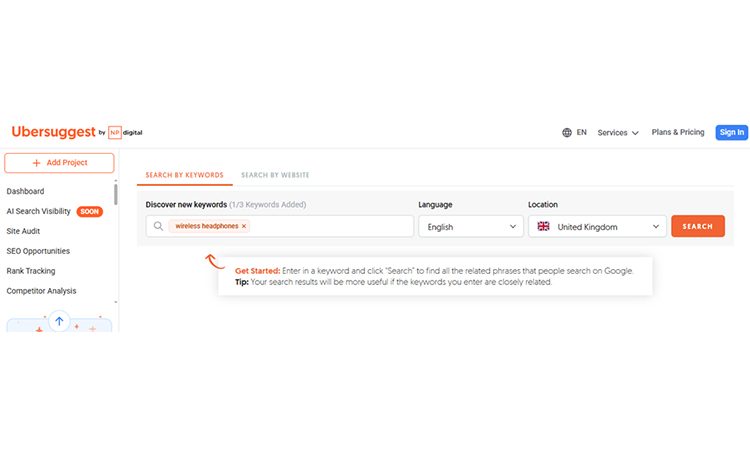
- Go to Ubersuggest and type a product keyword, like “wireless headphones.”
Step 2: Check Keyword Overview
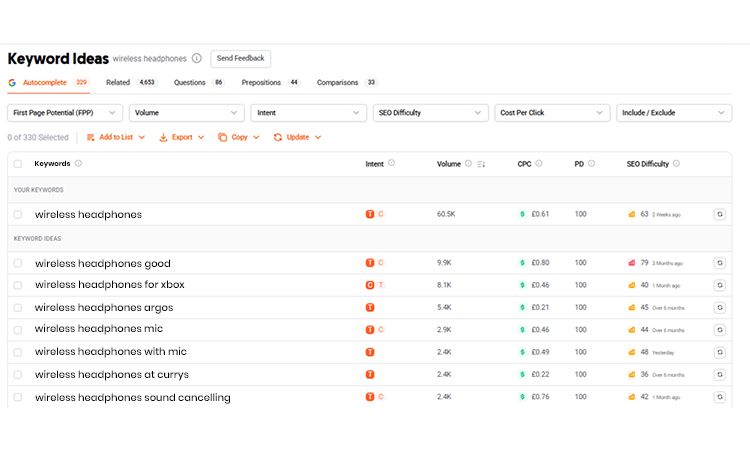
- You can examine search intent, search volume, CPC, SEO difficulty, and paid difficulty.
| Metric | Definition | Choosing Tips |
| Intent | The purpose behind a search (e.g., learning, comparing, or buying). | For product pages, focus on transactional intent keywords like “buy,” “shop,” or “best price.” |
| Search Volume | The number of times people search for a keyword in a month. | Select keywords with a medium-to-high volume that match your product, but avoid overly broad ones. |
| CPC (Cost Per Click) | The average cost advertisers pay for a click in paid ads. | A higher CPC typically indicates strong buyer intent. Use it to spot profitable keywords for conversions. |
| SEO Difficulty | How hard is it to rank for a keyword in organic search? | Choose keywords with low to medium difficulty if your site is new; aim higher as authority grows. |
| Paid Difficulty | How competitive a keyword is in paid advertising (PPC). | If paid difficulty is high, focus on organic SEO or find niche alternatives. |
Step 3: Explore Keyword Ideas
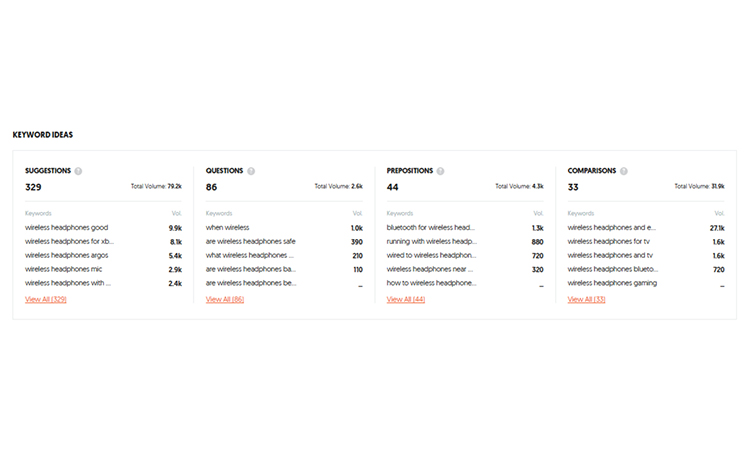
- Look for long-tail keywords like “wireless headphones with mic” or “best budget wireless headphones.”
Step 4: Dig Deeper Into Competitors
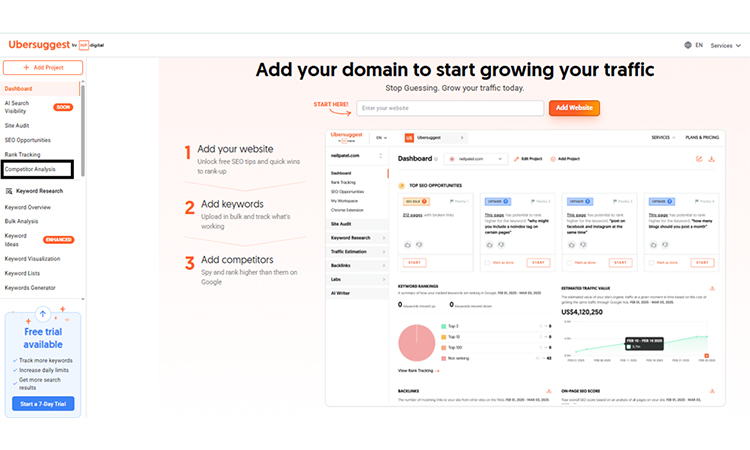
- Enter a competitor’s URL in Competitor Analysis. And get keywords that your rivals rank for.
- Check what keywords their product pages rank for.
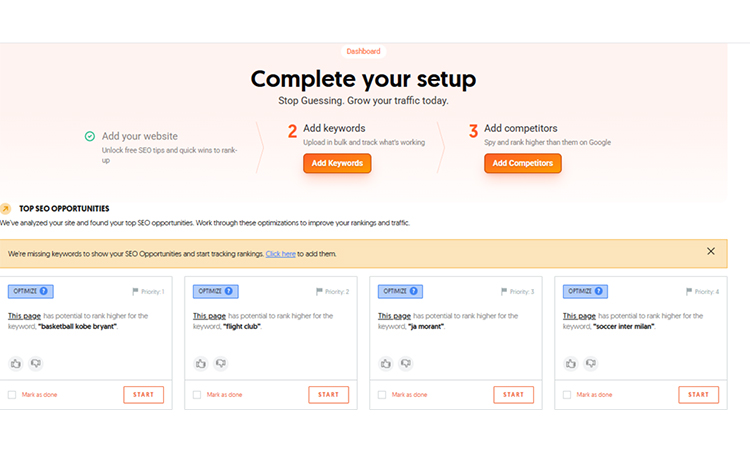
- Optimize Your Meta Title & Descriptions for Product Pages
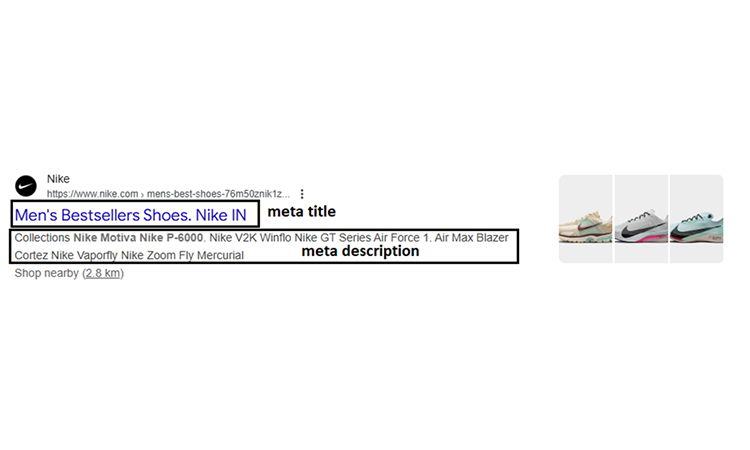
- Title Tag (Meta Title): The title that you can click on in search results. It shows people and search engines what the page is about.
- Meta Description: A summary (about 150–160 characters) under the title tag in search results. Rankings aren’t directly affected, but clicks are strongly affected.
These two things are very important for SEO on the product page because they make your product stand out in search results and make people want to click on it.
Steps to Optimize Title Tags for Product Pages
- Include Primary Keyword – Add the product name + main keyword.
- Add Unique Details—Mention brand, model, size, color, or features.
- Keep It Short & Clear—Aim for 50–60 characters so it doesn’t cut off in search results.
- Use a Call to Action (CTA)— Words like “buy,” “shop,” or “discover” can enhance your sales.
- Don’t do Keyword Stuffing- You have to avoid using the same keywords repeatedly in your descriptions or website content.
Example Title Tags:
- “Nike Air Force 1 White Men’s Sneakers | Free Shipping”
- “Chanel No. 5 Eau de Parfum – 100 ml Luxury Perfume | CHANEL”
Steps to Optimize Meta Descriptions
- Summarize the Product Clearly—Emphasize the benefit, not just the feature.
- Add Keywords Naturally—Reinforce your product name, type, or use.
- Keep It Under 160 Characters—Longer Ones Get Cut Off.
- Use Power Words & CTA—”Shop now,” “Limited edition,” and “Discover today” encourage clicks.
- Make It Unique for Every Product—Avoid duplicate meta descriptions across your store.
Example Meta Descriptions:
- “Shop the classic Nike Air Force 1 Men’s White Sneakers. Durable leather, all-day comfort, and free delivery. Order now and upgrade your style.”
- “Discover the timeless Chanel No. 5 Eau de Parfum. A luxurious fragrance with floral notes for women. Gift packaging available—shop today.”
- Develop Your Product Page URLs Properly
Product page URLs are very important for ecommerce websites. You have to properly optimize product pages URLS to get better conversion rates.
A product page URL is a web address that directs users to a specific product in your online store.
For example: www.mystore.com/mens-shoes/nike-air-zoom
- Good URL: www.mystore.com/laptops/dell-inspiron-15
- Bad URL: www.mystore.com/product?id=4567
This link informs both customers and search engines about the page’s content.
Best Tips for Product Page URLs
- Keep It Short and Clear—You need to prevent long, ambiguous strings like ?id=1234.
- Use Keywords—Then Add the Product Name or Main Keyword (e.g., “nike-air-zoom”).
- Use Hyphens, Not Underscores—Search engines favor hyphens to separate words.
- Keep It Lowercase—Impede errors and keep URLs the same.
- Avoid Stop Words—Moreover, you should eliminate redundant words like “the” or “and.”
Related: 10 Simple Steps to Compose an SEO-Friendly URL Structure
- Product Page Description Is a Must for Higher Rankings

Your ecommerce site consists of various products. So you have to write a compelling description of your product you’re selling.
You can take a Real Example of a Beauty Brand Product Description, like this-
How to Write Good Product Descriptions?
- Know Your Audience & Brand Voice
First, you need to decide if your brand is fun & playful, clinical & science-based, or luxurious. This established the tone.
Example: A clean-label skincare brand might use simple, soothing words. A luxury brand might use more poetic, rich phrasing. - Focus on Benefits Over Features
The product’s features explain what it does. Why it’s important.
E.g.- Feature: “Contains hyaluronic acid.”
- Benefit: “Helps skin lock in moisture and look plump and smooth.”
- Use Sensory, Emotional, Credible Language
- Sensory: texture (“velvety,” “silky”) or scent (“fresh citrus,” “soothing chamomile”)
- Emotional: Its impacts on humans and their emotions
- Credible: numbers, test results, certifications
- Make It Easy to Read/Scan
Use short paragraphs, bullet points, and headings. Most people scan rather than read word for word. - Include Key SEO Elements
- Use relevant keywords naturally (e.g., “anti-aging cream,” “hydrating serum”).
- Add meta descriptions, alt text, and title tags.
- Avoid duplicate copy (don’t reuse manufacturer text).
- Add Trust Signals & Social Proof
Customer reviews, star ratings, expert endorsements, number of users, etc. - Include How-To Use & Ingredients
Clearly list the ingredients (especially any possible allergies) and guide the customer in recognizing how to use or apply it.
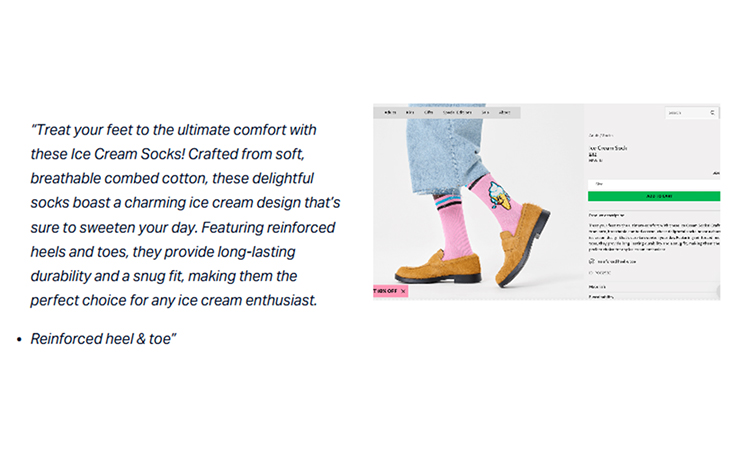
Best Tools for Optimizing Product Descriptions
There are various AI tools like ChatGPT, Claude, and Perplexity, which can help you generate product page descriptions. Moreover, you can evaluate your description with the following tools-
- Grammarly – for grammar, clarity, style
- Surfer SEO / Clearscope – to optimize for SEO, find related keywords
- Hemingway Editor – makes writing simple and readable
- Thesaurus / Power Thesaurus – for finding better sensory/ descriptive words
- Google Trends & Ubersuggest – for keyword research
- Optimized Images for the Ecommerce Product Page SEO
Image optimization is the process of ensuring that your product photos are of a high quality, load rapidly, have suitable titles and descriptions, and help in the recognition of the image by both users and search engines.
Image schema (structured data for images) helps add context to images so search engines can show them in rich results. It works alongside Product schema or ImageObject schema to convey details like what the image shows, its URL, captions, etc.
Here is another real-brand example of Nike.
Nike’s product image optimization for both SEO and user experience is superb.
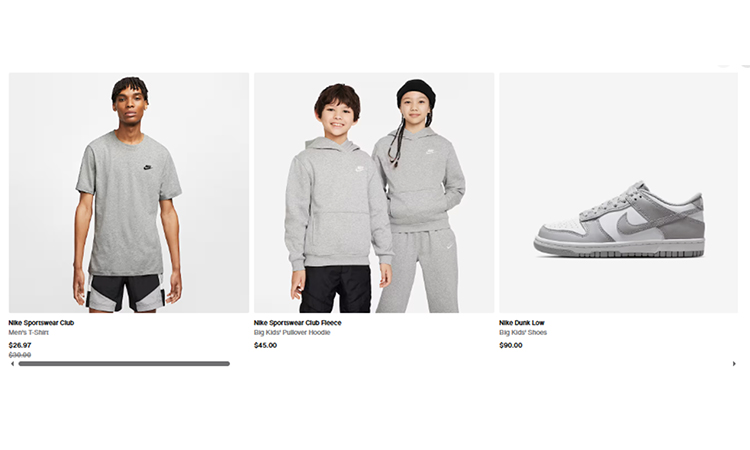
- Descriptive File Names & Alt Text
- The file names should include the product type and color, e.g., nike-air-force-1-white-sneakers.jpg instead of generic codes.
- Alt text describes the good, e.g., “Nike Air Force 1 Low Men’s White Leather Sneakers – Side View.”
- Multiple Angles & High-Quality Images
Nike’s product pages normally have between 5 and 7 customized pictures of each item, such as a side view, a top view, an on-foot look, and a lifestyle shot. The unique alt text for each picture makes them easier for people to find and use in search engines. - Performance Optimization
Nike uses adaptable pictures and new standards, such as WebP, to make sure that images load quickly on all devices. This helps with mobile optimization, which is very important for SEO on shop pages. - Structured Data / Image Schema
Product images on many Nike pages are annotated with Product and ImageObject schemas. This makes it easier for search engines to show product images in Google Shopping snippets or search results.
Real-Brand Example: Chanel

Chanel provides a strong example. Their product-image URLs are descriptive, containing product type, material, color, and even size information. They also use detailed alt text. For example:
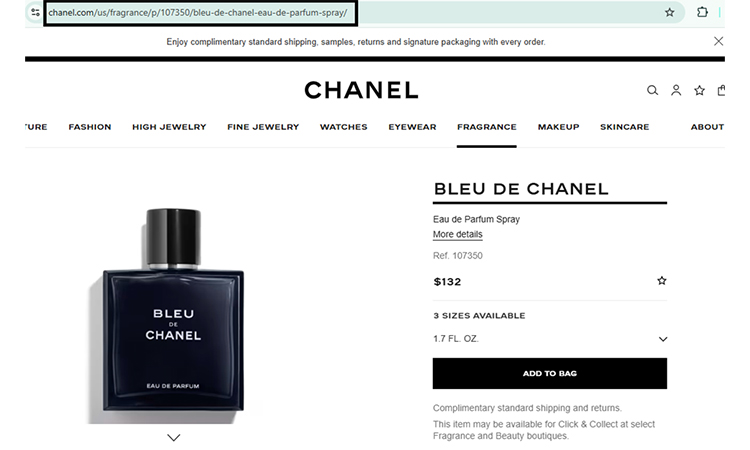
- Image URL:
…/chanel-no5-eau-de-parfum-luxury-crystal-bottle-100ml-gold-cap-close-up…jpg - Alt Text:
Img alt=”CHANEL No5 Eau de Parfum 100ml Luxury Crystal Bottle – Gold Cap – product close-up”
This helps search engines understand exactly what the product image is (not just a “perfume”), which improves image visibility in search image results and helps in overall product page SEO.
- Mobile Optimization, and Clear CTAs
Your e-commerce store will rank higher and get more new customers who understand the value and take the next step when it has mobile optimization and clear call-to-action buttons working together. Around 70% to 30% of retail users are on their phones, while only 2% are on tablets, so they are not shown.
The majority of consumers today shop via their smartphones. You could lose sales if your e-commerce product page doesn’t work well on mobile devices. Mobile optimization means adjusting design, speed, and usability so that customers understand the product and can buy it easily on smaller screens.
A mobile-optimized product page improves:
- Readability: Text and images adjust to screen size.
- Speed: Fast-loading pages reduce bounce rates.
- Conversions: A smooth experience leads to more completed purchases.
Steps for Mobile Optimization
- Responsive Design
Your website has to have a responsive layout. Product descriptions, product images, and call-to-action buttons should adjust automatically on mobile devices. - Compress and Optimize Images
Then you can choose formats like WebP and enable lazy loading so that images don’t slow down the page. - Readable Fonts and Clear Layout
The fonts should be large and easy to read to help customers understand product details without needing to zoom in. - Mobile-Friendly Navigation
Furthermore, you can implement breadcrumb navigation, folding menus, and a simple site structure to help shoppers avoid getting lost. - Test on Multiple Devices
On iOS, Android, tablets, and other browsers, you should always check how your product page looks.
Why Clear CTAs Are Important
For sales to happen, customers have to take action, even if your product page ranks well in search engines. That’s where call-to-action buttons (CTAs) come in. A clear CTA helps customers understand what to do next—whether it’s “Add to Cart,” “Buy Now,” or “Learn More.”
Steps for Effective CTAs
- Keep It Visible
Place CTA buttons above the fold (the part visible without scrolling) and repeat them lower down the page. - Use Strong Action Words
Statements like “Shop Now”, “Get Yours Today”, or “Add to Cart” are direct and persuasive. - Make It Stand Out
Use contrasting colors, bold text, and large buttons so customers don’t miss it. - Provide Reassurance
Increase reliability signals near the CTA, such as “Free Shipping”, “30-Day Returns”, or “Secure Checkout”. - Test and Improve
You can find out which CTA style, color, or language gets more conversions by doing A/B tests.
- Build Authority with User-Generated Content and Reviews
Your customers can make reviews, photos, videos, Q&As, and social media posts that are valuable. This is called user-generated content. This valuable content gives a human touch to your product pages and produces persuasive social proof that convinces visitors to buy additional products.
Why UGC builds authority for ecommerce SEO?
UGC transforms your website from a so-called sales pitch into a trusted resource. It generates real social evidence when potential customers see real people sharing their experiences. This improves conversions and helps other pages rank higher through natural keyword use and new content updates.
Types of User-Generated Content for Product Pages
- Customer Reviews and Ratings
- Text reviews: Comprehensive feedback about product experience
- Photo reviews: Customer images showing products in use
- Video reviews: Opening and explanation of content
- Q&A sections: responses to customer inquiries by other purchasers
- Social Media Content
- Instagram photos: Customers utilizing your goods
- TikTok videos: product demonstrations and advice on styling
- Facebook posts: Recommendations and experiences
- Twitter mentions: Quick reviews and feedback
- Community Content
- User forums: Discussions about different product variants
- Style guides: How-to content created by customers
- Comparison posts: Users who contrast several products.
- Tutorial content: Customers teaching others how to use products
Step-by-Step Implementation Guide
Step 1: Set Up Online Review Collection Systems
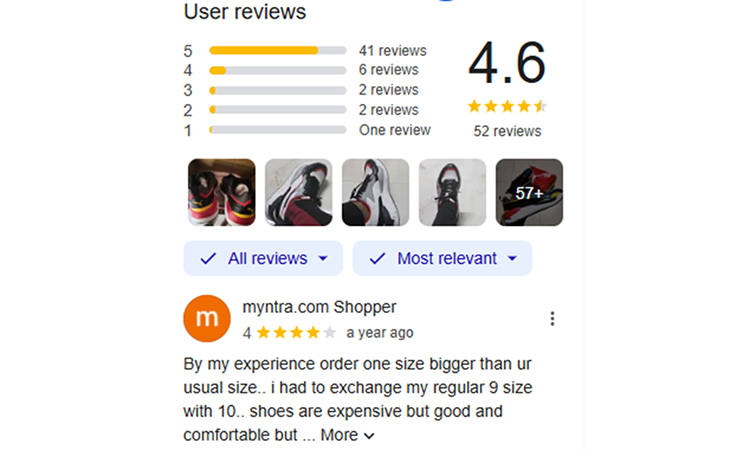
- Choose online review platforms: Google Reviews, Trustpilot, or native solutions.
- Install review widgets: Give review displays to all product pages.
- Automate review requests: Send emails 7-14 days after purchase.
- Create incentives: Offer small discounts for honest reviews.
Step 2: Encourage Photo and Video Content
- Create hashtags: Unique branded hashtags for social media
- Run contests: Photo contests featuring your products
- Offer rewards: points or discounts for sharing content.
- Make it easy: Simple upload tools on product pages
Step 3: Optimize UGC for SEO
- Moderate content: Ensure reviews are genuine and helpful.
- Respond professionally:Reply to reviews to show engagement.
- Use schema markup: Mark up reviews for rich snippets.
- Create dedicated pages: Feature customer stories and testimonials.
Step 4: Take Help From user-generated content for Link Building
- Share customer content:Repost on your social media with credits.
- Create case studies: Feature detailed customer success stories.
- Build relationships: Connect with customers who create great content.
- Guest opportunities: Help customers write content for other sites.
Cross-Promotion Tactics
- Display customer content across multiple product variants.
- Design comprehensive guide pages based on customer information.
- Employ customer feedback to write content for blog posts.
- Establish FAQ sections from common review themes.
Technical Integration
- Set up review syndication among comparable products.
- Enhance your backlink profile with mentions from user-generated content (UGC).
- Set up landing pages that users can use for certain topics.
- Combine product reviews with suggestions.
Community Building
- Create customer communities where users share tips.
- Host virtual events featuring your top reviewers.
- Develop loyalty programs rewarding content creators.
- Partner with micro-influencers from your customer base.
Key Metrics to Track UGC Success
- Review volume: Number of new reviews per month
- Review quality: Average rating and review length
- Content engagement: Social shares and comments
- Conversion impact: Sales from pages with UGC
- SEO benefits: Keyword rankings improvement
- Traffic growth: Visits to UGC-enhanced pages
Content Optimization Tips For Best Results
- You can develop unique product descriptions (never copy manufacturer descriptions).
- Then you may add included keywords naturally in titles and descriptions.
- Your FAQ sections should deal with customer concerns.
- Moreover, use customer reviews as user-generated content.
Customer Experience Improvements
- Add product videos and 360-degree views.
- Display real-time inventory levels.
- Show estimated delivery dates.
- Include size charts and buying guides.
- Implement one-click purchasing options.
- Earn High Quality Backlinks
You can link to your product pages from credible, related websites are called high-quality backlinks. They’re like trust indicators from other websites. When authoritative sites link to your products, Google sees this as proof that your content is valuable and legitimate, which enhances your rankings significantly.
Advanced Link Building Strategies for Product Pages
- Create Linkable Product Content
Product Comparison Guides
- Develop detailed comparison charts featuring your products alongside competitors.
- Include technical specifications, pros/cons, and use cases.
- Make these guides so comprehensive that industry blogs want to reference them.
Technical Product Documentation
- Create in-depth installation guides and user manuals.
- Develop troubleshooting resources that solve common problems.
- Build specification sheets that become industry references.
Industry Research Using Your Products
- Conduct studies showing how your products perform in real-world conditions.
- Create data-driven reports about industry trends related to your products.
- Publish original research that journalists and bloggers can cite.
- Make use of product uniqueness
Innovation Stories
- Write down how you’re producing your products..
- Then present information that shows how things are made behind the scenes.
- Make case studies that show how your goods can be used in specific ways.
Patent and Technology Content
- Clarify proprietary technology in accessible terms.
- Make educational content about innovations in your industry.
- Share the science behind your product features.
- Strategic Partnership Link Building
Supplier and Manufacturer Relationships
- Get featured on supplier websites as a success story.
- Collaborate on co-branded content with manufacturers.
- Participate in supply chain case studies.
Complementary Business Partnerships
- Partner with businesses that serve the same customers.
- Create joint product bundles with link exchanges.
- Develop collaborative content addressing shared customer needs.
Industry Association Links
- Join relevant trade organizations and get listed in member directories.
- Participate in industry events and get mentioned in event coverage.
- Contribute expert insights to association publications.
- Content Marketing That Links to Products
Educational Content Strategy
- Create how-to guides that naturally mention your products as solutions.
- Develop buyer’s guides that feature your products alongside alternatives.
- Build resource hubs that become go-to references in your industry.
Newsjacking and Trend Participation
- Comment on industry news with your unique perspective.
- Participate in trending discussions while subtly showcasing expertise.
- Create timely content that addresses current events affecting your industry.
- Digital PR for Product Pages
Product Launch Campaigns
- Coordinate product announcements across multiple platforms.
- Reach out to industry publications with exclusive launch coverage.
- Create press kits with high-quality images and detailed information.
Awards and Recognition
- Submit products to relevant industry awards.
- Apply for “best of” lists in your category.
- Pursue certifications that come with directory listings.
Expert Positioning
- Offer expert commentary on industry developments.
- Participate in podcast interviews discussing your products.
- Contribute guest articles to industry publications.
- Community and Social Link Building
User Community Development
- Create forums or communities around your products.
- Encourage user-generated content that gets shared and linked.
- Develop customer success stories that other businesses reference.
Social Proof Amplification
- Turn customer testimonials into link-worthy case studies.
- Create video testimonials that get embedded on other sites.
- Develop customer spotlight features that attract industry attention.
Advanced Tactics for Competitive Advantage
Broken Link Building for Ecommerce
- Find broken links to discontinued products in your category.
- Contact webmasters offering your products as replacements.
- Create superior alternatives to outdated resources.
Resource Page Link Building
- You need to find pages that list useful tools and goods for your business.
- Then make free tools that are actually useful and link them to your goods.
- Reach out to the people who manage reference pages with useful improvements.
Unlinked Brand Mentions
- Monitor mentions of your products across the web.
- Contact those websites that mention your products without linking.
- Provide additional value to convert mentions into links.
Measuring Backlink Success
Track these key metrics to measure your link-building effectiveness:
- Domain Authority of linking sites
- Relevance of linking websites to your industry
- Traffic driven from backlinks to product pages
- Conversion rates from backlink traffic
- Ranking improvements for target product keywords
Tools for Backlink Analysis and Outreach
Free Tools:
- Google Search Console for monitoring new links
- HARO (Help a Reporter Out) for PR opportunities
- Social media listening tools for mention tracking
Premium Tools:
- Ahrefs for comprehensive backlink analysis
- Semrush for competitor link research
- BuzzStream for outreach campaign management
- Strengthen Technical SEO for Ecommerce Product Page
You can think of technical search engine optimization as the important foundation for your ecommerce site structure. You need to maintain some technical considerations to improve your product page ranking on search engines. Here are some basic components of the technical part of your website.
Site Structure & Internal Linking
The links between your website pages are like a map for people and Google. It’s not enough for internal links to just help SEO; they should also help customers find what they need.
Steps to implement:
- Create clear category paths: Home → Category → Subcategory → Product
- Add breadcrumb navigation on every product page.
- Link related products within descriptions (not just in sidebars).
- Use descriptive anchor text like “waterproof running shoes” instead of “click here.”
- Put together topic clusters with links from the main category pages to the right product pages.
What Is Breadcrumb Navigation?
- One sort of website navigation that helps users see the sequence of pages they went through to get to the current page is called breadcrumb navigation. It makes sense because shoppers can easily go back to a broader category page without clicking “Back” multiple times.
- It typically appears near the top of a webpage as a small trail of links.
- Breadcrumbs add a human touch by showing where the product fits in the overall store layout.
- If a user doesn’t like one product, they can quickly browse other products in the same category.
For example, on an ecommerce store selling shoes, the breadcrumb may look like this:
Home > Men’s Shoes > Running Shoes > Nike Air Zoom
This shows the user:
- They’re currently on the Nike Air Zoom product page.
- It fits below Running Shoes, which is under Men’s Shoes, starting from Home.
Core Web Vitals Optimization
Google’s method of determining how quickly and smoothly your website is to use.
The three key metrics:
- Loading speed: the speed at which your primary information appears
- Interactivity: How quickly buttons and links respond when clicked
- Visual stability: Whether elements jump around while loading
Steps to optimize:
- Compress product images to under 100 KB without sacrificing quality.
- Then you may choose the WebP image format instead of JPEG/PNG.
- Turn on browser caching for returning visitors.
- Eliminate JavaScript that blocks page rendering.
- Use lazy loading for images below the fold.
Page Speed for Customer Experience
Beyond Core Web Vitals:
- Optimize database queries for product information.
- Use Content Delivery Networks (CDNs).
- Implement progressive loading for product galleries.
- Minimize third-party scripts.
HTTPS Security
The “S” in HTTPS informs customers and Google that your website is safe for shopping.
Implementation steps:
- Install an SSL certificate on your entire website.
- Convert all HTTP pages to HTTPS versions.
- Modify internal links to use HTTPS.
- Fix mixed content warnings (HTTP sections on HTTPS pages).
- Upgrade XML sitemaps with HTTPS URLs.
Canonical Tags
It helps search engines understand which is the main page of your website. This can prevent duplicate content issues and consolidate link equity.
Common e-commerce scenarios:
- Product available in multiple colors/sizes
- Same product in different categories
- Filter pages creating duplicate content.
How to implement:
- Include canonical tags that link to the main product URL.
- On each unique page, use self-referencing canonicals.
- Avoid canonical chains (A→B→C).
- Keep canonicals the same across multiple categories.
Schema Markup (Structured Data)
Schema Markup, also known as structured data, is extra code that you include on your product pages. It supports search engines like Google in figuring out your product’s details, such as price, reviews, availability, and brand. When search engines better understand your page, they can return more detailed results (such as star ratings, prices, and stock status). This differentiates your product and can increase clicks and conversion rates.
Implementation example:
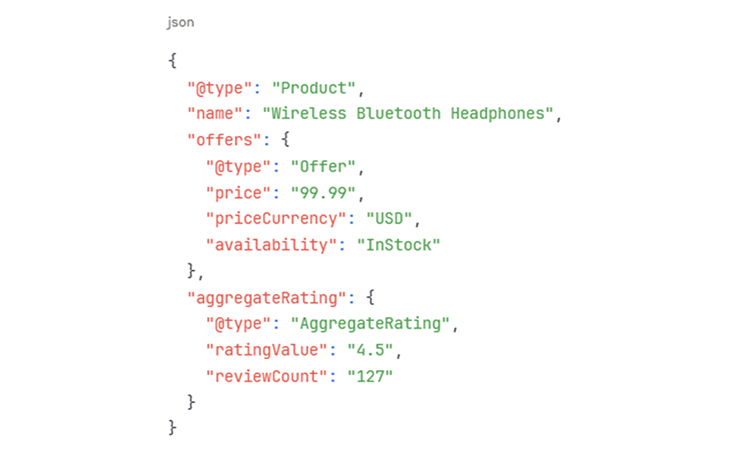
Essential product schema elements:
- Product name and description
- Price and currency
- Availability status
- Customer reviews and ratings
- Brand information
- Product images
- SKU and GTIN numbers
Steps to Implement Schema Markup
Step 1: Choose the Right Schema Type
- For product pages, use Product Schema.
- This includes details like product name, brand, price, and reviews.
Step 2: Add Essential Properties
- Name: The product title.
- Image: A high-quality product image.
- Description: Summary of the product.
- Offers: Price and availability.
- AggregateRating & Review: Customer ratings and feedback.
Step 3: Use Tools to Generate Schema Code
- Use Google’s Structured Data Markup Helper or Schema.org generator.
- These tools give you ready-to-use JSON-LD code.
Step 4: Add Code to Product Page
- Paste the JSON-LD code into the <head> section of your product page.
Step 5: Test Your Markup
- Use Google’s Rich Results Test to check if your schema is valid.
XML Sitemaps for Products Page
An XML sitemap is a special file that lists all of your website’s key pages, including product pages in an ecommerce store. It makes it easier for search engine crawlers such as Google to find and index your content. Some product pages (particularly new ones or those buried deep within the site structure) may be missed if a sitemap is not provided.
For example, if your online store sells 500 shoes, an XML sitemap ensures that every product page is visible to search engines. This enhances product page SEO and raises organic traffic.
Steps to Create and Use an XML Sitemap for Products
Step 1: Generate a Sitemap
- You can utilize tools like Yoast SEO (WordPress), Screaming Frog, or an online XML sitemap generator.
- Your product page should be included with this.
Step 2: Organize URLs
- The essential part is canonical tags. It has to include only canonical URLs (not duplicates).
- Then you have to keep your sitemap clean—avoid broken or redirected product pages.
Step 3: Submit Sitemap to Google
- Go to Google Search Console.
- Upload your sitemap file (usually at: yourstore.com/sitemap.xml).
Step 4: Update Regularly
- Whenever you add new products or remove old ones, update your XML sitemap.
Essential Tools for Product Page Optimization
Free Tools
- Google PageSpeed Insights: Test Core Web Vitals
- Google Search Console: Monitor technical issues
- Google Rich Results Test: Validate schema markup
- Screaming Frog SEO Spider: Audit technical issues
Paid Tools
- SEMrush Site Audit: Comprehensive technical analysis
- Ahrefs Site Explorer: Track technical SEO progress
- GTmetrix: Detailed performance monitoring
- Schema Pro: Easy schema implementation
E-commerce-Specific Tools
- Google Merchant Center: Product feed optimization strategies
- Shopify SEO apps: Platform-specific optimization
- WooCommerce SEO plugins: WordPress store optimization
Start Implementing Today
- Week 1: Fix HTTPS and basic site structure issues
- Week 2: Optimize Core Web Vitals and mobile experience
- Week 3: Implement product schema markup
- Week 4: Audit and fix canonical tag issues
Remember: Technical SEO is a continuous procedure. So you need to update and check regularly. Moreover, you can decide on one component at a time, evaluate results, and then move to the next improvement.
The objective is to develop a significant component of your marketing strategy that helps consumers locate and purchase more goods while offering a first-rate user experience all along the way.
- Monitor, Analyze, and Refine (Using Analytics & A/B Testing)
After product page optimization correctly you need to analyze the result to see how it is going.
Watch these numbers weekly:
- Organic search visitors to each product page
- Bounce rate (people leaving immediately)
- Time spent on product pages
- Pages viewed per session
Conversion Tracking
Monitor conversion data monthly:
- Product page conversion rates
- Cart abandonment rates
- Revenue per visitor
- Customer acquisition costs
Essential Analytics Tools
Google Analytics 4-Set up to enhance e-commerce tracking to see:
- Which products get the most traffic?
- Where visitors come from before buying
- Which pages cause people to leave your site?
- Revenue generated from each product page optimization
Google Search Console- You can check this data monthly:
- Search terms bringing people to your products
- Page ranking positions
- Click-through rates from search results
- Technical errors affecting transparency
A/B Testing for Product Pages
Run tests on these elements:
- Product titles and descriptions
- Image layouts and numbers
- Button colors and text
- Price display formats
- Customer review sections
Testing Process
- Pick one element to change.
- Create two versions of your page.
- Split traffic between both versions.
- Run the test for at least two weeks.
- Choose the winning version.
- Test the next element.
Simple Testing Tools
- Google Optimize (free basic testing)
- Shopify built-in A/B testing
- WooCommerce testing plugins
- Unbounce for landing page tests
Monthly Analysis Routine
Week 1: Traffic Review
Check which products get the most visitors. Look for pages with dropping traffic and investigate why.
Week 2: Conversion Analysis
Find products with low conversion rates. These pages need immediate attention and testing.
Week 3: Technical Health Check
Use tools to scan for broken links, slow loading times, and mobile issues.
Week 4: Competitor Research
See what successful competitors are doing differently with their product pages.
Quick Wins from Data
Low-Hanging Fruit
- Fix pages with high traffic but low conversions.
- Improve slow-loading product images.
- Add missing product information
- Update out-of-stock product status.
Content Improvements
- Rewrite product descriptions with better keywords.
- Add more customer photos and reviews.
- Create FAQ sections for common questions.
- Include size charts and purchasing guides.
You can take Data-Driven Decisions
Never guess what customers want. Use real data to guide changes:
- If customers leave quickly, you should write better descriptions of your products.
- Use SEO and keywords to bring in more visitors if you’re not getting many.
- Should conversions be low, try out various layouts.
- If mobile visitors don’t convert well, you should fix the mobile experience.
Let’s Draw Our Conclusion
At the end of our discussion on e-commerce product page SEO, I can assume you have all the necessary details of how you can implement this e-commerce SEO strategy. However, if you have any further questions or need clarification on any points, you can take help from one of the best e-commerce SEO companies available to you. Though you can implement the strategy on your own, if you take professional guidance, it can increase your rank and convert more leads. It will ultimately save your time and resources in the long run.
So, if you want to hold your position in the competitive e-commerce market, you need to optimize your e-commerce product page SEO properly and effectively. It will give your e-commerce store a huge spike in online visibility and sales. That’s how you can convert your potential clients into loyal customers.

